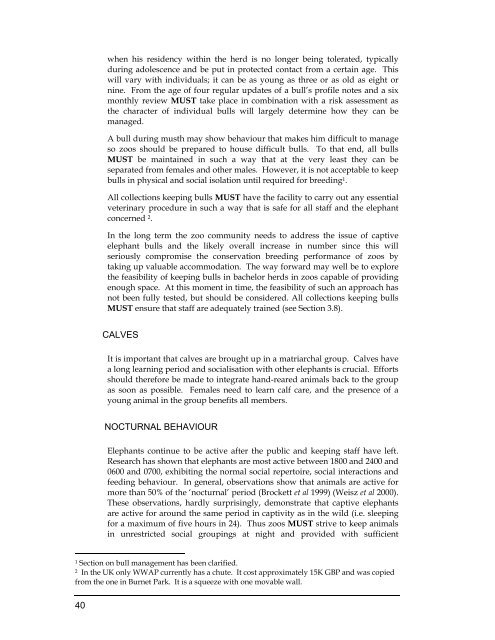Elephants Elephants - Wildpro - Twycross Zoo
Elephants Elephants - Wildpro - Twycross Zoo
Elephants Elephants - Wildpro - Twycross Zoo
You also want an ePaper? Increase the reach of your titles
YUMPU automatically turns print PDFs into web optimized ePapers that Google loves.
40<br />
when his residency within the herd is no longer being tolerated, typically<br />
during adolescence and be put in protected contact from a certain age. This<br />
will vary with individuals; it can be as young as three or as old as eight or<br />
nine. From the age of four regular updates of a bull’s profile notes and a six<br />
monthly review MUST take place in combination with a risk assessment as<br />
the character of individual bulls will largely determine how they can be<br />
managed.<br />
A bull during musth may show behaviour that makes him difficult to manage<br />
so zoos should be prepared to house difficult bulls. To that end, all bulls<br />
MUST be maintained in such a way that at the very least they can be<br />
separated from females and other males. However, it is not acceptable to keep<br />
bulls in physical and social isolation until required for breeding 1.<br />
All collections keeping bulls MUST have the facility to carry out any essential<br />
veterinary procedure in such a way that is safe for all staff and the elephant<br />
concerned 2.<br />
In the long term the zoo community needs to address the issue of captive<br />
elephant bulls and the likely overall increase in number since this will<br />
seriously compromise the conservation breeding performance of zoos by<br />
taking up valuable accommodation. The way forward may well be to explore<br />
the feasibility of keeping bulls in bachelor herds in zoos capable of providing<br />
enough space. At this moment in time, the feasibility of such an approach has<br />
not been fully tested, but should be considered. All collections keeping bulls<br />
MUST ensure that staff are adequately trained (see Section 3.8).<br />
CALVES<br />
It is important that calves are brought up in a matriarchal group. Calves have<br />
a long learning period and socialisation with other elephants is crucial. Efforts<br />
should therefore be made to integrate hand-reared animals back to the group<br />
as soon as possible. Females need to learn calf care, and the presence of a<br />
young animal in the group benefits all members.<br />
NOCTURNAL BEHAVIOUR<br />
<strong>Elephants</strong> continue to be active after the public and keeping staff have left.<br />
Research has shown that elephants are most active between 1800 and 2400 and<br />
0600 and 0700, exhibiting the normal social repertoire, social interactions and<br />
feeding behaviour. In general, observations show that animals are active for<br />
more than 50% of the ‘nocturnal’ period (Brockett et al 1999) (Weisz et al 2000).<br />
These observations, hardly surprisingly, demonstrate that captive elephants<br />
are active for around the same period in captivity as in the wild (i.e. sleeping<br />
for a maximum of five hours in 24). Thus zoos MUST strive to keep animals<br />
in unrestricted social groupings at night and provided with sufficient<br />
1 Section on bull management has been clarified.<br />
2 In the UK only WWAP currently has a chute. It cost approximately 15K GBP and was copied<br />
from the one in Burnet Park. It is a squeeze with one movable wall.

















